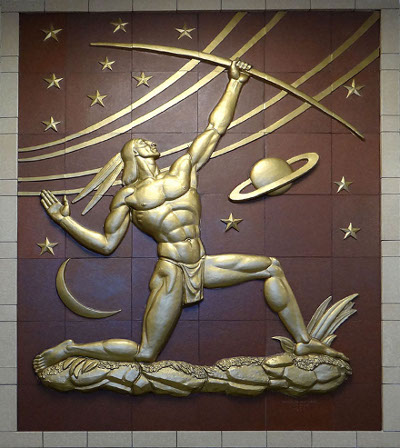Wheeler Williams was born on November 30, 1897 in Chicago, Illinois. He studied sculpture at the School of the Art Institute of Chicago. He attended Yale where he graduated Magna cum Laude in 1919 after having served in the U.S. Balloon Corps during World War I. He received a Master of Architecture degree from Harvard in 1922. Like most of his peers, Williams went to Paris to gain exposure to European sculpture and life. He studied at the École des Beaux-Arts in Paris under Jules Coutan and only returned to the United States in 1928.
He specialized in the carving of allegorical reliefs. During the 1930s, he completed works in this genre for the Interstate Commerce Building, Washington, D.C., and for the Post Offices on Canal Street, New York, and in Bay Shore, Long Island. The last two commissions were done under the auspices of the Federal Works Agency.
Like many artists at the time, Williams was a political activist. Unlike many, he was a political conservative. He strongly supported the House Un-American Activities Committee's search for communists in the arts and protested the Congressional censure of Joseph McCarthy. Williams was also called to serve on the jury of the famous Alger Hiss treason trial.
Beyond public projects, Williams also created the monument Settling of the Seaboard, done in 1941 for Fairmount Park, Philadelphia, and the two large allegorical figures representing the odd pair of Venus and Manhattan executed in the early 1950s for the facade of the Parke-Bernet Galleries on Madison Avenue in New York. He created a number of fountain figures, for example, The Wave of Life Fountain for the Prudential Building in Houston, Texas, and the Rhthym of the Waves Fountain for the Grosse Pointe Yacht Club in Detroit. The model for the former work was shown at the National Academy in 1960 (National Academy cat. no. 4). His eight small, lead fountain sculptures of the gods as children - Neptune, Hercules, and Venus, for example - were exhibited at the Arden Gallery in New York in 1940. Four of these are now at Brookgreen Gardens. Evidence of Williams's competence as an animalier is seen in a number of his bronze creatures which are at Brookgreen as well. Williams became an active exhibitor at the National Academy beginning in 1938 and won the Ellin Speyer Memorial Prize here for his Black Panthers in 1940 (National Academy cat. no. 310).
His medals include the Stephen Potter Memorial Medal (Phillips Exeter), Chester Plimpton (Yale), American Spirit Honor (U.S. Army), Insignia (Citizens Committee for Army and Navy), Colin Kelly, John Flanagan (Century Association), and 50th Anniversary (Medallic Art Company Competition, 1950).
He served as president of the National Sculpture Society and was a founder and president of the American Artist Professional League. He was active in the armed forces during both world wars.
Sourced mainly from Wikipedia.











